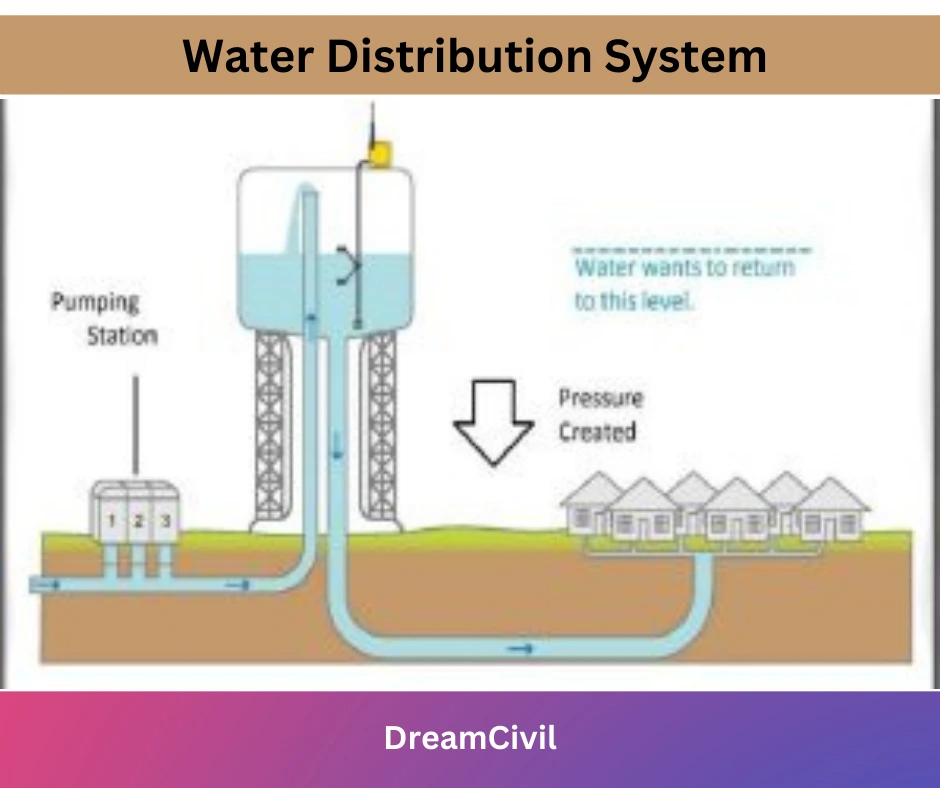Table of Contents
The process of distributing treated water to the consumers is called a water distribution system.
The distribution system includes pumps, reservoirs, valves, water meters, pipe fittings, etc.
The cost of the distribution system is about 40-70 % of the total of the entire scheme.
A sound water distribution system aims to supply water to all the consumers whenever required in sufficient quantity with required pressure without any leakage.
1. Requirements of the Good Water Distribution System
1. The system should be economical to maintain and operate.
2. Sufficient water should reach all consumers.
3. It should be able to draw enough water during an emergency like fire fighting.
4. The system should be watertight, and leakage should be least as possible.
5. Any type of contamination of water should not occur during the distribution.
6. It should not be laid below the sewer lines as far as possible.
7. The system should have adequate pressure, but the pressure should not be high, causing the bursting of pipes and fittings.
8. The distribution layout should be such that it should supply water even during repair and maintenance time.
2. Methods of Supplying Water
There are two methods of supplying water.
a. Continuous system
b. Intermittent system
a. Continuous System
A continuous system of water supply is the best method by which the water is supplied to the community during all 24 hours of the day.
In this system, a sufficient amount of water is always available for consumers to use and for emergencies like firefighting.
Due to the continuous circulation, water remains fresh, but the losses will be more if there are leakages in the system.
i. Working on Continuous System
Water demand is high in the morning and evening and very low at night.
To tackle peak demand and hourly fluctuations, balancing reservoirs are commonly utilized.
The balancing reservoir gets recharged during low demand times and serves during peak demand.

ii. Advantages of Continuous System
i. Due to continuous circulation, water remains fresh.
ii. Water is available for users in sufficient quantity 24/7.
iii. Pipes of lesser size are required for distribution.
iv. Emergency demands like fire demands can be met within time.
iii. Disadvantages of Continuous System
i. Water loss during water distribution is high.
ii. Requirement of more water at the source.
iii. Increase in water wastage due to lack of civic sense.
b. Intermittent System
If adequate water is unavailable, the whole community is divided into several zones, and water is supplied in each zone for a fixed time of the day or on alternate days.
The water flows into the consumer’s tap at specific intervals. So, it is called an intermittent system.
Consumers are generally advised to treat the water from the intermittent system as water becomes stagnant in service reservoirs. Bleaching powder is also used to maintain the residual chlorine level.
| Read More: Water Treatment Process |
i. Working on an Intermittent System of Water Supply
The working of the intermittent system is quite simple.
~ At first, the distribution area is divided into several zones.
~ Then, water is supplied to only a few zones based on the schedule. This is done to maintain the proper pressure at the consumer’s tap.

ii. Advantages of Intermittent System of Water Supply
a. Fewer water leakages and losses as compared to a continuous system.
b. Easy for repair and maintenance works as repairs can be done during out-of-supply hours.
iii. Disadvantages of Intermittent System of Water Supply
a. Water is provided to the consumers for a limited time.
b. High cost of construction and requirement for more numbers of valves and other distribution accessories.
c. Fire demand cannot be met in time.
d. Bigger diameter pipes are required.
e. Requirement of more workforce as compared to continuous.
3. Methods of Water Distribution System
For efficient distribution, it is required that water should reach every consumer at the required rate of flow.
Therefore, the same pressure in the pipelines is necessary, which should force the water to reach every place.
The distribution systems can be classified as follows:
a. Gravity Flow System
When the distribution reservoir is located at a higher elevation than the target community, water is supplied with the gravity flow. Such a system is called Gravity Flow Water Distribution System.
This method is much more suitable when the source is the river or impounded reservoir at sufficient height than the target community.

Usually, pumping water is not required at any stage of this distribution.
In hilly or high altitude regions, water supply is generally done by the gravity method. There is no control of water pressure in pipelines.
Due to the high gradient, the water velocity is also very high. So, Break Pressure Tanks are built at suitable distances to reduce the hydrostatic pressure in the pipe.
i. Working of Gravity Flow Water Distribution System
~ Water source in this system is generally a spring, river, or impounded reservoir at a higher elevation.
~ Water from the source is conveyed to the treatment plant with the help of intake structure and transmission mains.
~ Treatment plant is usually located at a lower elevation than the source and near the source.
~ Treated water is sent to the distribution reservoir. Such stored water is distributed to the consumers by gravity flow as the targeted community lies at a lower elevation than the distribution reservoir.
ii. Advantages of Gravity Flow Water Distribution System
1. No energy is required to operate the system as water is conveyed by gravity.
2. No pump is required.
3. Economical for long-term use.
iii. Disadvantages of Gravity Flow Water Distribution System
1. Not applicable in plain or flat terrain where an elevation source of water supply is not available.
2. Water loss by leakage is comparatively higher.
3. Requirement of break pressure tanks to reduce the hydrostatic pressure in the pipelines.
| Read More: Break Pressure Tank |
b. Pumping System
In the pumping water distribution system, water is supplied to the consumers with the help of pumps.
Some extra pumps are also installed for emergency causes like fire hazards, peak water demand, etc.
This method is suitable if the source is at a lower elevation than the target community.
However, this system of distribution becomes very expensive for long-term use.
In this system, the water may be insufficient when the power fails. So diesel pumps are also managed as an alternative.
This method has no problem with the pressure and maintaining the head at the consumer’s tap.
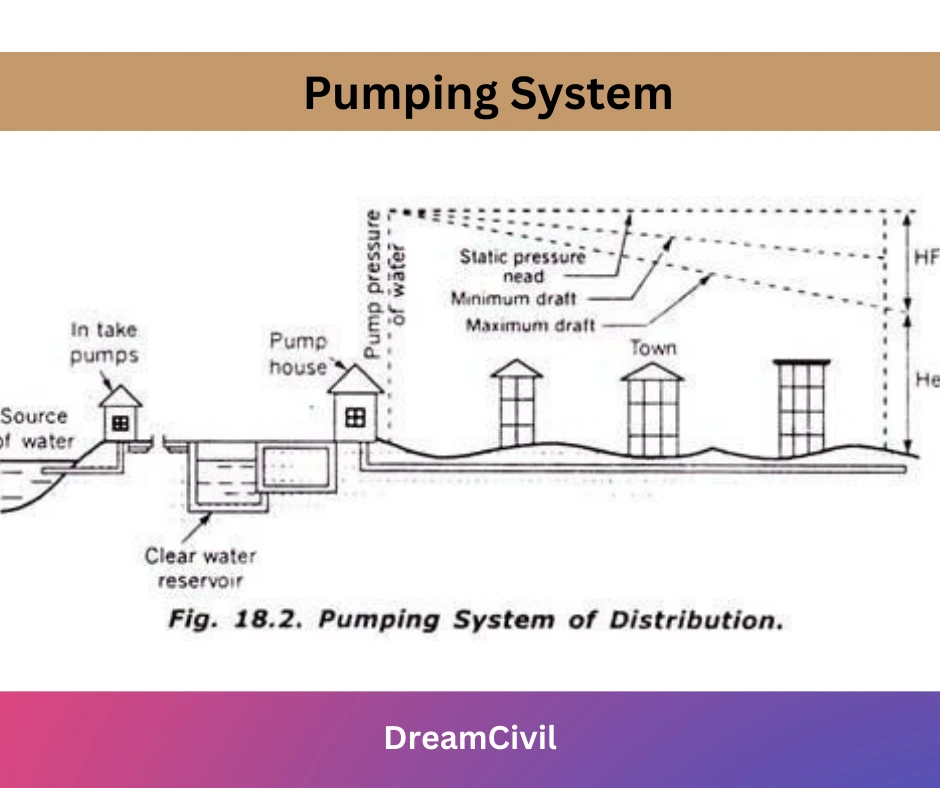
i. Working of Pumping Water Distribution System
~ Pump ( at intake structure) is utilized to supply the water to the transmission mains, which conveys the water to the treatment plant.
~ After treating water, it is stored in service reservoirs from which water is distributed to the consumers using pumps.
ii. Advantages of Pumping Water Distribution System
1. Water can be pumped only when required.
2. Low water loss due to leakage.
iii. Disadvantages of Pumping Water Distribution System
1. Breakdown of the system may occur if power fails.
2. Maintenance and operation cost is high.
3. During pumping hours, water inflow through leaks may cause water contamination.
c. Combined Gravity and Pumping System
It is a combination of a gravity system and a pumping system. So it is called the Dual System.
In this system, the treated water is pumped and stored in an elevated reservoir, from where it is supplied to the consumer by gravity.
i. One Way System
In this system, water is pumped to the elevated reservoir and then supplied to the consumers by gravity.
The distribution network is connected with an elevated reservoir but not with direct distribution pumps, as shown in the figure above.
ii. Two-Way System
In this system, separate pumps are provided for direct distribution and elevated reservoirs where an elevated reservoir is used for backup in an emergency, power failure, etc.
4. Types of Distribution Network In Water Distribution System
In general, there are four types of distribution network systems. They are:
a. Dead End or Tree system
b. Gridiron System
c. Circular or Ring System
d. Radial System
a. Dead End or Tree System
The dead-end system is also referred to as a tree system.
This system consists of one main pipe from which several sub-mains bifurcate, and from each sub-main several separate branch pipes, called laterals.
From laterals, connections are given to different houses.
This system is easy to design and is cheap and simple.

Water conveyance is only unidirectional in this system so that water can reach a specific point solely through one route. Thus, if any fault creep in the water system gets disturbed in that area.
This system has many dead ends which prevent the free circulation of water, thereby increasing the possibility of water contamination.
Discharge can’t be increased in case of a fire breakout.
Dead-end mains over 1,000ft should be at least 6 inches in diameter.
i. Suitability
This type of distribution system is suitable for old cities.
ii. Advantages of Dead End Water Distribution System
a. It is relatively cheaper.
b. Design and calculation of the dead-end system are easy.
c. Requires less number of valves; this makes it easier to determine discharges and pressures.
iii. Disadvantages of Dead End Water Distribution System
a. The single pipeline serves the region. One problem in the pipeline may lead to a cut-off of the water supply of a large area.
b. Presence of many dead ends causes stagnation of water in pipes.
c. Discharge of water is relatively low.
b. Grid Iron System
A grid iron water distribution system is called a reticulation or interlaced system.
The system consists of one main pipe, which runs through the center and consists of branches and laterals, which run in a grid pattern.
Since the mains, branches, and laterals are interconnected, dead ends are laminated, and water reaches different locations through more than one route.
By closing cut-off valves of other areas’ pipes, water can be diverted to the affected area at the time of the fire.
There is significantly less chance of recontamination because there are no dead ends.
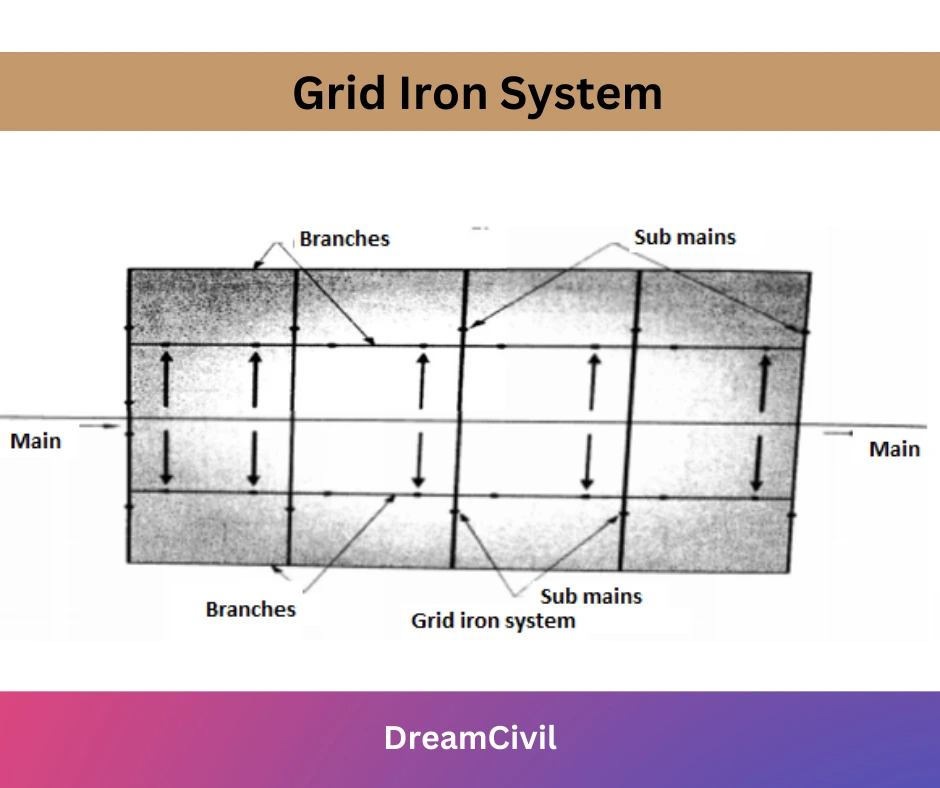
The design of this system is complicated because pipelines get water from different directions.
The size of the pipes is larger, and more sluice valves are required.
i. Suitability
It is most applicable for a planned city where roads and streets are provided in well-planned rectangular and squares grid patterns ( i.e., Roads are at the right angle to each other. )
ii. Advantages of Grid Iron System
a. The absence of a dead-end reduces the chances of pollution due to stagnation.
b. During repair and maintenance work, the small region is only affected.
c. Availability of enough water at street fire hydrants.
iii. Disadvantages of Grid Iron System
a. Requirement of a massive number of cut-off valves.
b. Requirement of longer pipes with a larger diameter.
c. Difficult to determine discharge, pressure, and velocities in the pipelines.
d. less economical.
c. Circular or Ring System
In the ring water distribution system, the supply main forms a ring around the distribution area.
The branches are connected cross-wise to the mains and also to each other.
This system is most reliable for a town with well-planned streets and roads.
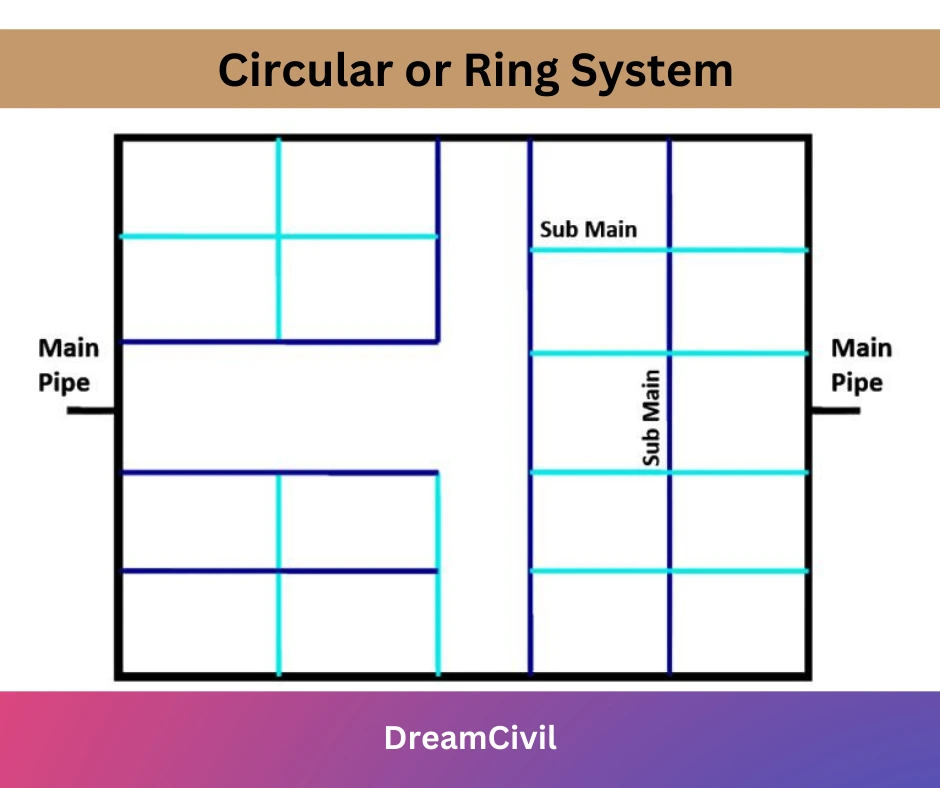
i. Advantages of Ring Water Distribution System
~ Minimum head loss due to less number of interconnections.
~ High discharge.
~ Very few consumers are affected during repair and maintenance work.
ii. Disadvantages of Ring Water Distribution System
~ High initial cost due to requiring more pipes and valves compared to other systems.
d. Radial System
In this system, the city is divided into parts, and each contains a centrally located distribution reservoir (elevated).
The distribution pipes are laid radially ending towards the periphery and are connected to the central distribution reservoir.
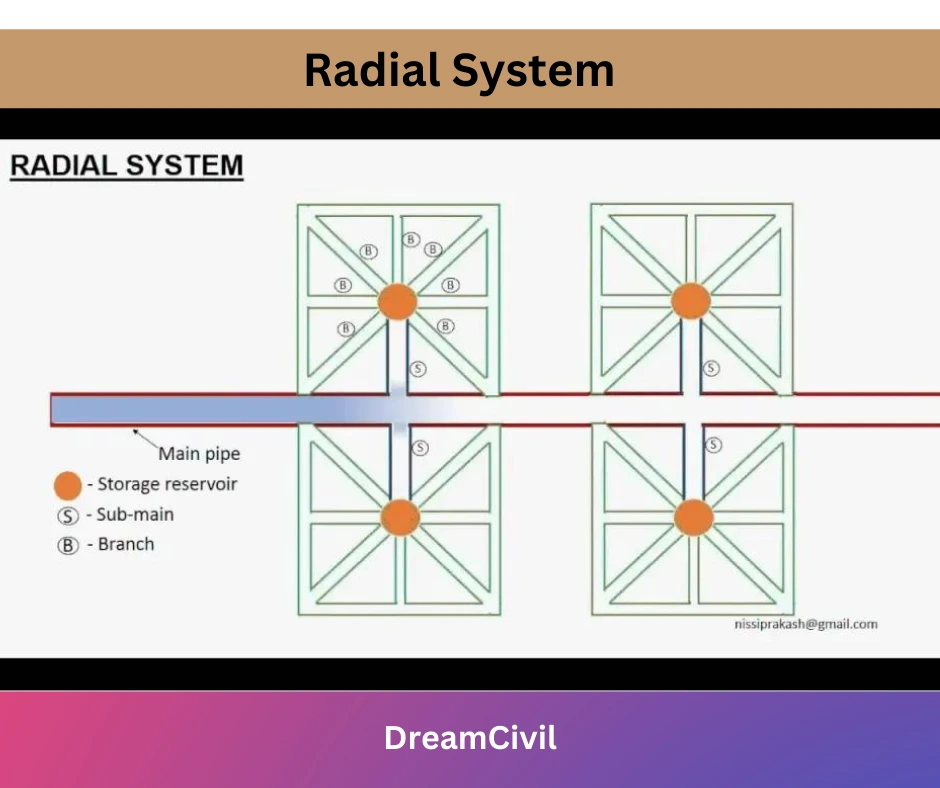
i. Advantages of the Radial System
a. Easy to determine pipe size.
b. This system provides quick service.
c. Due to high discharge and minimum head loss, this system is used in high-rise buildings.
d. Few consumers are only affected during repairing and maintenance work.
ii. Disadvantages of the Radial System
a. Design of this system is very complicated.
b. More length of pipe is required as the connection is more in this system.
| Read More: Water Treatment Process |
| Read More: Water Demand |

